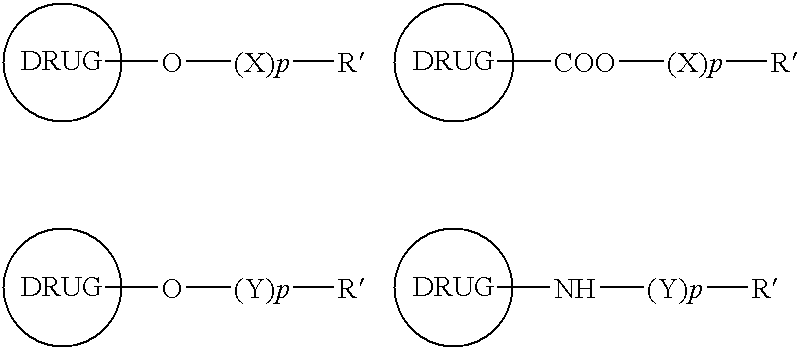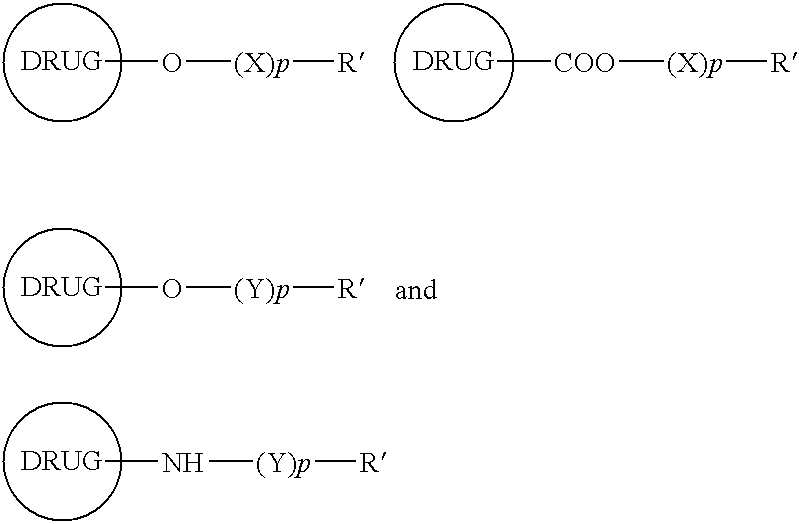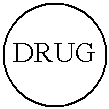Functionalized drugs and polymers derived therefrom
- Summary
- Abstract
- Description
- Claims
- Application Information
AI Technical Summary
Benefits of technology
Problems solved by technology
Method used
Image
Examples
example 1
2-Methoxycarbonylmethoxy-benzoic acid methyl ester (1)
[0139]
[0140] To a mixture of methyl salicylate (100 g, 657 mmol) and anhydrous K2CO3 (360 g, 2.605 mol) in anhydrous acetone (1000 ml) was added methyl chloroacetate (94 g, 866 mmol) and refluxed for 36 hours. The acetone was distilled off and water (1200 ml) was added. Crude 1 was extracted into chloroform, dried over Na2SO4 distilled and purified by column chromatography on silica gel using hexane as eluant to give pure 1 (25 grams, 17%) as a light yellow syrup.
[0141] The structure was confirmed by NMR. 1HNMR (CDCl3) 3.79(s, 3H,ester), 3.88 (s,3H,ester), 4.70(s,2H,OCH2), 6.88(dd,1H,Ar), 7.03 (m,1H,Ar), 7.42(m,1H,Ar), 7.81(dd,1H,Ar)
example 2
2-(1-Methoxycarbonylethoxy)benzoic acid methyl ester (2)
[0142]
[0143] To a mixture of methyl salicylate (100 g, 657 mmol), anhydrous K2CO3 (360 gr, 2.605 mol) and sodium iodide (5 g, 33.3 mmol) in anhydrous acetone (1000 ml) was added methyl 2-chloro propionate (104 g, 849 mmol) and refluxed for 48 hours. Acetone was distilled off and water (1200 ml) was added. Crude 2 was extracted into ethyl acetate, dried over Na2SO4, distilled and purified by column chromatography on silica gel using hexane as eluant to give pure 2 (35 grams, 22.4%) as a light yellow syrup. The melting point was measured for the products by using Polmon (MP 96) melting point apparatus, and IR was run using Perkin Elmer FTIR Spectrophotometer, Model: Spectrum RXI FTIR. For all compounds, NMR was run using Varian 200 MHz and tetramethyl-silane as the internal standard. The structure for this was confirmed by NMR.
[0144] HNMR (CDCl3) 1.58(d, 3H,CH3), 3.65(s,3H,ester), 3.82(s,3H,ester), 4.72(q,1H,CH), 6.78 (d,1H,Ar)...
example 3
2-(5-Methoxycarbonylpentyloxy)benzoic acid methyl ester (3)
[0145]
[0146] To a mixture of methyl salicylate (50 g, 329 mmol), anhydrous K2CO3 (180 grams, 1.30 mol) and sodium iodide (5 grams, 33.3 mmol) in anhydrous acetone (600 ml) was added methyl 6-bromo hexanoate (76 g, 364 mmol) and refluxed for 40 hours. Acetone was distilled off and water (750 ml) was added. Crude 3 was extracted into ethyl acetate, dried over Na2SO4, distilled and purified by column chromatography on silica gel using hexane as eluant to give pure 3 (55 grams, 60%) as a light yellow syrup. The structure was confirmed by NMR.
[0147]1HNMR (CDCl3) 1.60 (m, 2H,CH2), 1.72 (m, 2H,CH2), 1.77 (m, 2H,CH2), 2.35 (t, 2H,CH2), 3.66 (s,3H,ester), 3.88(s,3H,ester), 4.02(t,2H,OCH2), 6.90(m,2H,Ar), 7.38(m,1H,Ar), 7.74(d,1H,Ar)
PUM
| Property | Measurement | Unit |
|---|---|---|
| Temperature | aaaaa | aaaaa |
| Volume | aaaaa | aaaaa |
| Mass | aaaaa | aaaaa |
Abstract
Description
Claims
Application Information
 Login to View More
Login to View More - R&D
- Intellectual Property
- Life Sciences
- Materials
- Tech Scout
- Unparalleled Data Quality
- Higher Quality Content
- 60% Fewer Hallucinations
Browse by: Latest US Patents, China's latest patents, Technical Efficacy Thesaurus, Application Domain, Technology Topic, Popular Technical Reports.
© 2025 PatSnap. All rights reserved.Legal|Privacy policy|Modern Slavery Act Transparency Statement|Sitemap|About US| Contact US: help@patsnap.com



